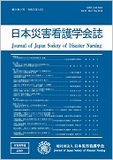Japanese
English
- 有料閲覧
- Abstract 文献概要
- 参考文献 Reference
要約
目的:避難所での生活経験を有する高齢者は、その避難所における生活環境を、どのように認識しているかを明らかにし、避難所における看護について検討することである。
方法:質的記述的研究。東日本大震災後、小学校体育館での避難生活経験を持つ高齢者5名に半構造的面接法を用い、生活環境について感じていたことや思いに関する内容や文脈に注目し、逐語録からコード、サブカテゴリ、カテゴリへと抽象化した。
結果:研究参加者は63歳〜82歳、避難所の生活期間は19〜139日間であった。抽出された21サブカテゴリから、【日常生活はしにくい】【日常生活のしにくさは仕方がない】【日常生活のしにくさに対し自分たちで工夫する】【日常生活のしにくさは乗り越えられる】の4カテゴリが導かれた。生活のしにくさは仕方ないと覚悟し、自分で工夫しながら次第に慣れていき、乗り越えられると認識していた。
結論:避難所は、人が健康な営みをする為の環境にはなく、研究参加者の我慢や工夫で慣れることが求められていた。看護師は、避難所の生活環境の調整と日常生活の観点を活用しながら、看護専門職としての知識と技術を積極的に発揮していく支援を行う必要がある。
Purpose: The purpose of this descriptive study was to clarify how older adults perceived living in a public school sports hall used as an evacuation shelter. This is important for considering how the living environment and nursing in shelters can be improved.
Method: Research participants were five elderly people who experienced evacuation life in an elementary public school sports hall after the Great East Japan Earthquake. Data-gathering consisted of semi-structured interviews and surveying related to the public school sports hall. The data were analyzed using qualitative descriptive analysis.
Results: The participants were 63 to 82 years old, and lived in shelters for 19 to 139 (mean 87.8) days. Analysis resulted in 4 categories: “Daily life was difficult,” “The difficulties of daily life couldn&t be helped,” “Reinvent ourselves due to the difficulty of daily life,” “We can overcome the difficulties of daily life.” Participants faced difficulties in daily life which they tolerated or for which they devised solutions that gradually allowed them to become accustomed to living in a shelter.
Conclusion: For evacuees to live with enhanced health in shelters, nurses are urged to use their knowledge pro-actively, including making living environment adjustment and providing support for daily activities.
Copyright © 2019, Japan Society of Disaster Nursing All rights reserved.


